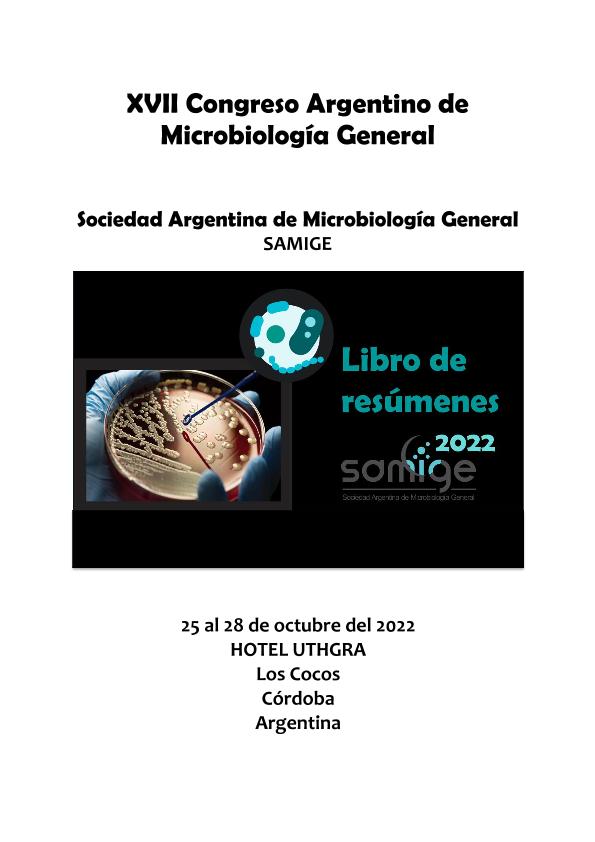Evento
Aspergillus biomass production from sugarcane vinasse and its potential use for fish farm feed
del Gobbo, Luciana Melisa ; Pérez Iglesias, Juan Manuel
; Pérez Iglesias, Juan Manuel ; Jorquera, A.; Cortes, Agostina; Villegas, Liliana Beatriz
; Jorquera, A.; Cortes, Agostina; Villegas, Liliana Beatriz ; Colin, Veronica Leticia
; Colin, Veronica Leticia
 ; Pérez Iglesias, Juan Manuel
; Pérez Iglesias, Juan Manuel ; Jorquera, A.; Cortes, Agostina; Villegas, Liliana Beatriz
; Jorquera, A.; Cortes, Agostina; Villegas, Liliana Beatriz ; Colin, Veronica Leticia
; Colin, Veronica Leticia
Tipo del evento:
Congreso
Nombre del evento:
XVIII Congreso Argentino de Microbiología General
Fecha del evento:
25/10/2022
Institución Organizadora:
Sociedad Argentina de Microbiología General;
Título del Libro:
Libro de Resúmenes del XVII Congreso Argentino de Microbiología General
Editorial:
Sociedad Argentina de Microbiología General
Idioma:
Inglés
Clasificación temática:
Resumen
Fish farming development faces several challenges, including the unavailability of good quality and affordable fish feeds. Thus, debate over fish farming is focused on fostering a shift from conventional feeds (fishmeal and soybean meal) to less expensive protein sources such as biomass of some fungal species. Elaborating new policies for improving the management of distillery effluents such as vinasse is relevant throughout the worldwide. Hence, recycling of vinasse for the manufacture of value-added fungal biomass could reduce production costs of fish feed and environmental impact of distillery effluents. In a previous study, it was demonstrated the tolerance of the fungus Aspergillus sp. V1 to high sugarcane vinasse concentrations. The goal of this study was to determine the bromatological composition of fungus biomass produced from vinasse to be used for fish feed formulations. A feed test with different proportions of lyophilized fungus was also performed, using the Guppy fish (Poecilia reticulata) as a model. Biomass produced from vinasse supplemented with 2 g/L urea at 30 °C for 96 h was harvested by pouring out the culture through a fine mesh stainless sieve and washed with distilled water, prior analyses. Total proteins of lyophilized biomass were determined by the Kjeldahl-Arnold-Gunning method using the universal factor of conversion to protein 6.25, total fat (or lipids) by the Soxhlet gravimetric method, crude fiber by the official method (OMA-Official Methods of Analysis), moisture by heating under reduced pressure, ash by weight difference after calcining the sample, and in carbohydrates indirect form: total carbohydrates = 100 – (Proteins + Total Fat + Moisture + Ash). For feed test, a chronic study (28 days) was carried out with different administrations of the lyophilized fungus (0%, 50% and 100%) compared to a commercial food (Shulet Carassius). As variables, parameters related to fish growth (body condition index, K) and enzymes related to oxidative stress (catalase and TBARS) were evaluated. Under the current assay conditions, biomass analysis revealed a protein content (44.0%), fat (3.9%), ash (5.2%), fiber (5.6%), moisture (5.2) and carbohydrate (37.0) within the standards recommended for fish diets. Regarding feed test, the results show a high survival (80%) in the fish fed with the lyophilized fungus compared to fishes feeding with commercial food (50%). Also, the statistical analyzes showed similarity between all the treatments in K index. However, the statistical analyzes revealed significant increases in the enzymes related to oxidative stress in the fishes where commercial food was administered (catalase value: 0.012; TBARS: 28.25) compared to those fed with lyophilized fungus (catalase value: 0.005 to 0.006; TBARS: 21.64 to 26.43). These results demonstrate that Aspergillus sp. V1 grown on vinasse may be used as an inexpensive fish feed ingredient, providing the benefits of a sustainable development across society.
Palabras clave:
FISH FARMING
,
FUNGUS BIOMASS
,
VINASSE
,
BIOASSAYS
Archivos asociados
Licencia
Identificadores
Colecciones
Eventos(PROIMI)
Eventos de PLANTA PILOTO DE PROC.IND.MICROBIOLOGICOS (I)
Eventos de PLANTA PILOTO DE PROC.IND.MICROBIOLOGICOS (I)
Citación
Aspergillus biomass production from sugarcane vinasse and its potential use for fish farm feed; XVIII Congreso Argentino de Microbiología General; Los Cocos; Argentina; 2022; 150-150
Compartir



